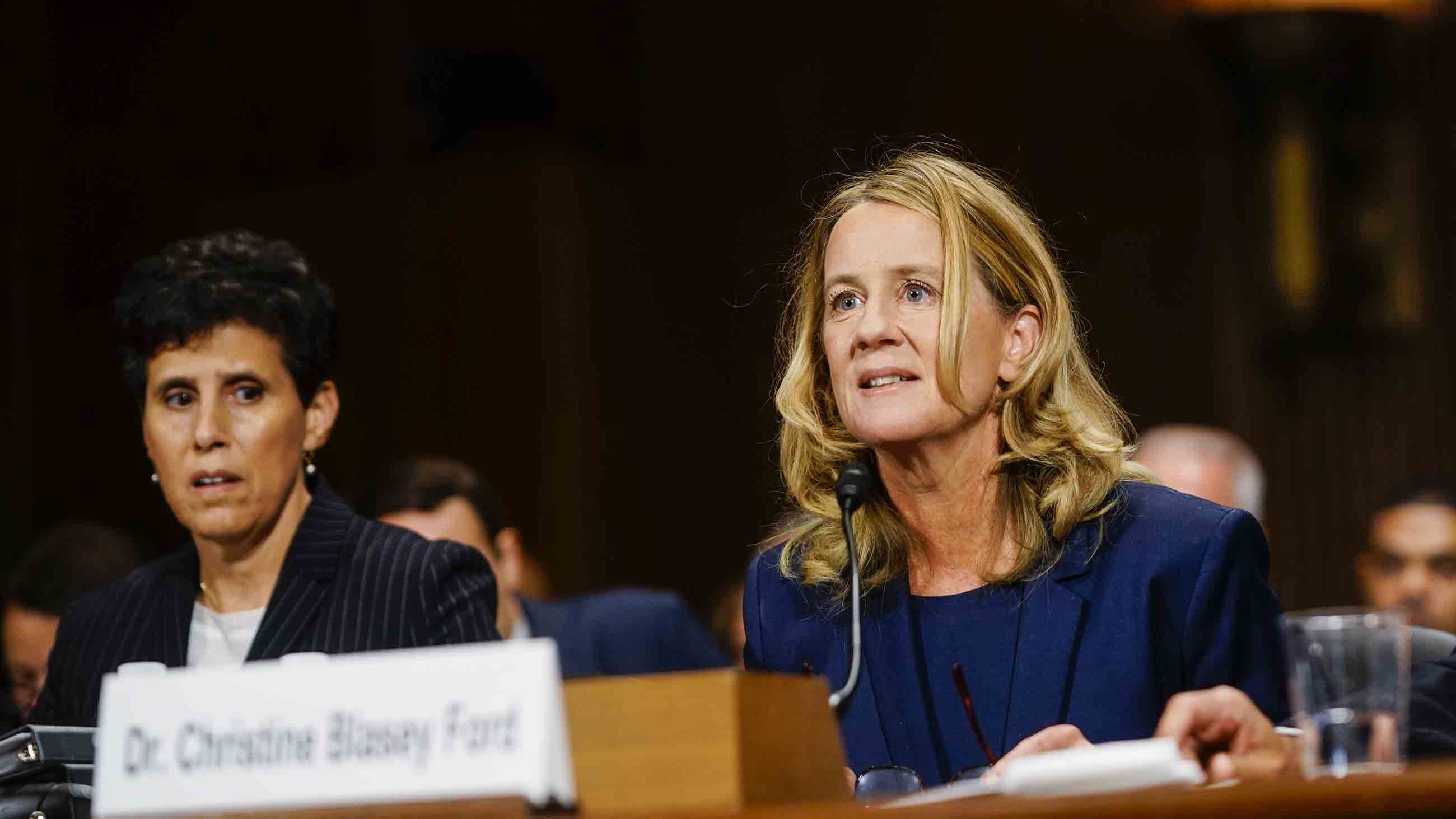All eyes were on Christine Blasey Ford on Thursday as the Palo Alto University psychology professor testified before a Senate committee about her claims of sexual assault by Supreme Court nominee Brett Kavanaugh — who continues to adamantly deny allegations that he assaulted Ford during a high school party in the summer of 1982.
Ford, when questioned, said she was 100-percent certain that Kavanaugh was her attacker, while Kavanaugh’s supporters — and even Kavanaugh himself — have raised questions about whether Ford’s recollection is reliable. The problem: Latching onto discrepancies in small details of recollection is misguided, according to scientists who understand memory — including Ford herself.
According to Linda Levine, a professor of psychology at the University of California, Irvine, when an event occurs, specific pieces of information are encoded and stored in a person’s brain, with priority being given to those details they were paying most attention to in the moment. While some details inevitably become fuzzy or are forgotten over time — the location or exact timing of an assault, Levine told Vox, the big picture tends to stick with people.
Jim Hopper, an expert in psychological trauma and a teaching associate at Harvard Medical School, echoed that sentiment in remarks published Thursday in Scientific American. “As memory researchers love to say,” Hopper wrote, “memory is not like a videotape.” The brain always stores certain memories more strongly than others, especially during traumatic events.
“Sometimes we get confused,” he continued. “Sometimes other people, or even movies we watch, supply inaccurate details that are inadvertently re-encoded into the overall memory and its abstract story. But memories of highly stressful and traumatic experiences, at least their most central details, don’t tend to fade over time.”
These realities might well be contributing to a chorus of new voices calling for a delay in Kavanaugh’s confirmation to the nation’s high court, so that a full investigation of the incident — along with other similar allegations that have been made against the nominee — can be completed. This includes the American Bar Association, which called for an FBI investigation into the charges on Friday morning. Just one month ago, the legal association had given Kavanaugh its highest recommendation.
As it stands, the Senate Judiciary Committee is scheduled to vote on Kavanaugh Friday, with the final vote planned for next week.
Also in the news:
• The United States’ national parks are suffering extreme climate change effects, according to a study published this week in Environmental Research Letters, which attributes the harm to the fact that many of the parks are located in high risk environments. The authors — from the U.S. National Park Service, the University of California, Berkeley and the University of Wisconsin-Madison — specifically cited the concentration of parks in the Arctic, high elevations, or the arid southwestern deserts. Those locations, according to Berkeley climate researcher Patrick Gonzalez, are being exposed to “hotter and drier conditions than the U.S. as a whole.” Temperature, for instance, has increased most in Alaska, which has an extensive system of national parks. And when reductions in precipitation were calculated, from 1895 and 2010, the scientists found drought stress across 12 percent of national parklands compared to 3 percent of the country as a whole. A Park Service spokesman said information such as that contained in the report would be considered in management decisions, but emphasized that climate was only one of many factors considered by the agency. (The Washington Post)
• A decade ago, Congress passed the Health Information Technology for Economic and Clinical Health Act to spur a national transition from paper medical records to electronic ones — and indeed, many hospitals and doctors’ offices have done so. But even today, paper records linger, and according to an extensive report in Undark this week, newer electronic health records often use proprietary software that makes it just as hard — or even harder — to move patient information between medical facilities. That leaves many families and health care professionals forever scrambling to piece together the mosaic of a patient’s medical history as they inevitably move from doctors’ offices to specialists, from specialists to hospitals, and from hospitals to clinics. And this, says Dr. Ilana Yurkiewicz, can lead to haphazard, redundant, and sometimes inappropriate care. “When a patient with a complex medical history … arrives under my care, it’s like opening a book to page 200 and being asked to write page 201,” Yurkiewicz writes. “That can be challenging enough. But on top of that, maybe the middle is mysteriously ripped out, pages 75 to 95 are shuffled, and several chapters don’t even seem to be part of the same story.” (Undark)
• On the eve of flu season comes a stark reminder of just how lethal the virus can be: An estimated 80,000 Americans died of flu and flu-related complications last winter, according to new data from the Centers for Disease Control and Prevention. That toll, the highest in four decades, dwarfs the 56,000 deaths recorded during the 2012-13 season, previously the worst in recent history. “It was just a tremendous amount of disease,” Daniel Jernigan, head of the CDC’s influenza division, told the Washington Post. CDC officials say the estimate may be slightly revised, but it’s not expected to go down. Although it’s hard to pinpoint why the 2017-18 season was so deadly, the CDC reports that it was one of the longest flu seasons in years: Cases ticked up in November, peaked in February, and remained high through the end of March. And in continuation of a discouraging trend, less than half of Americans received flu shots. Roughly four in five pediatric deaths last year occurred in children who had not received a flu vaccination. (Associated Press, The Washington Post)
• The Environmental Protection Agency has placed the head of its Office of Children’s Health Protection, Dr. Ruth Etzel, on administrative leave. The office, created by former President Bill Clinton in 1997, touts its mission as ensuring “ that all EPA actions and programs address the unique vulnerabilities of children.” Due to their size and continued development, children are more susceptible for the effects of pollutants and may ingest harmful substances through certain behaviors such as crawling and putting things in their mouths. The EPA declined to say why it was placing Etzel, a pediatrician and epidemiologist who has been studying children’s environmental health for over 30 years, on leave, but did state that she is not facing disciplinary action and will continue to be paid. But the move comes after clashes between the children’s health office and EPA leadership under the Trump administration, which has worked to roll back environmental regulations including regulations on pollutants. “This seems like a sneaky way for the EPA to get rid of this program and not be upfront about it,” said Dr. Mona Hanna-Attisha, whose work on blood tests in Flint, Michigan helped show that residents were being exposed to too much lead. (The New York Times)
• The World Health Organization (WHO) warned Tuesday that a recent outbreak of Ebola, the seventh-largest in history, may spin out of control because of insecurity brought on by war in the Democratic Republic of the Congo. With the disease’s epicenter based in North Kivu, DRC, a region facing conflict and armed attacks on civilians by opposition groups, WHO was forced to halt its containment and response efforts there for one week due to dangerous circumstances. Since the Ebola outbreak was declared on August 1, there have been 150 confirmed and probable cases and more than 100 people have died. Politicians are reported to have exploited peoples’ fears, causing some who could receive the experimental Ebola vaccine to refuse it. The WHO acknowledges a worst-case scenario would involve the Ebola virus spreading into the war’s “no go” zones and across the border of DRC. Even in the unstable political climate in the DRC, more than 11,000 doses of the experimental vaccine have been administered. (Vox)
• And finally: 132 million. That’s the number of breached, lost, or stolen medical records from 2010 to 2017, according to a new study in the Journal of the American Medical Association. During that same period, however, data breaches classified as “theft” declined by nearly two-thirds. How to make sense of this? “More breaches happen — for the sake of argument — in doctor’s offices, quote-on-quote ‘health care providers,’” says Thomas McCoy, the paper’s co-author and the director of the Massachusetts General Hospital Center for Quantitative Health, “but more records get lost by big insurance companies.” In fact, a lot more records get lost by these companies — about 110 million, or 63 percent of those reviewed by the center. And as electronic health records become more common, says McCoy, data breaches may continue to rise. The irony is that while thieves steal data, hospitals don’t share patients’ records among themselves. The collective costs to patients, hospitals, and the economy as a whole are impossible to quantify, but by some estimates amount to billions of dollars. What’s worse, an untold number of patients undergo duplicate procedures — or fail to get them at all — because key pieces of their medical history are missing. (Forbes)










